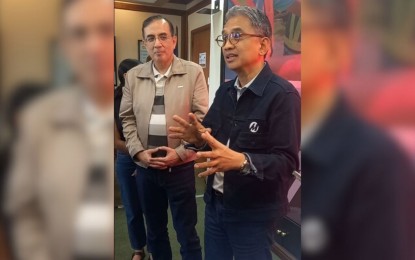MANILA – Pangilingan-led Manila Electric Company (Meralco) is preparing for more technological innovation in the energy sector but is waiting for the revised rules from the Energy Regulatory Commission (ERC) for the first regulatory period.
During a briefing after a tour of Meralco’s command center in Pasig City, officials stated that their modernization efforts include smart meters, which provide real-time electricity consumption monitoring for customers.
The company plans to deploy 11 million smart meters under a 10-year program, pending ERC approval of Meralco’s rate reset application, which outlines investment, operations, and pricing plans.
Also part of this initiative is the establishment of the Grid Edge Operations and Control Center (GEOCC), a state-of-the-art operations center that will manage Meralco assets and interconnected facilities for last-mile end users.
Other programs under this plan include distributed energy resources, net-metering, embedded generation, and electric vehicle (EV) charging stations in more Meralco franchise areas.
“These will allow Meralco to transition to a potential future role as a Distribution System Operator,” officials said.
Investment figures were not disclosed pending the ERC policy.
“The GEOCC will be part of the whole application to be submitted to the ERC for the next regulatory period, so its rollout will depend on ERC approval,” they added.
Meanwhile, officials noted that their current equipment is strong enough to withstand and provide power even during a magnitude 8 earthquake, depending on the location.
“What we really want is we anticipate disaster, we absorb the impact, and then we adapt,” they said.
They also mentioned that their System Average Interruption Frequency Index (SAIFI) to date is around 1.04 times, meaning that on average, one customer experiences a power interruption 1.04 times a year, lasting an average of 180 minutes.
“We are at par with Southeast Asian countries and rural utilities in the US,” they said.
During the same event, officials stated that the power distribution utility has invested heavily in the distribution system and backbone “so that if any calamity, whether it’s an earthquake or a strong typhoon, we will be able to somewhat withstand.”
“But at the same time, we have a very strategic protocol in place wherein our network crews are strategically located so we can respond almost instantaneously as long as the situation allows it,” they said.
Manila Electric Company
The Manila Electric Company (Meralco) is the Philippines’ largest private-sector electric distribution utility, established in 1903 during the American colonial period. It has played a central role in powering the development of Metro Manila and surrounding provinces for over a century, evolving from a street railway and electricity provider into the primary power distributor for the country’s most populous region.
Pasig City
Pasig City is a highly urbanized city located in Metro Manila, Philippines, which served as the provincial capital of Rizal before the formation of the national capital region. Historically, it was a significant settlement along the banks of the Pasig River, playing a crucial role in trade and transportation during the Spanish colonial era. Today, it is a major residential and commercial hub, known for business centers like the Ortigas Center and landmarks such as the Immaculate Conception Cathedral.
Energy Regulatory Commission
The Energy Regulatory Commission is a government agency responsible for overseeing and regulating a country’s energy sector, such as electricity and natural gas. It was typically established to ensure fair competition, protect consumer interests, and promote reliable energy services following the privatization or liberalization of energy markets. Its history is often tied to reforms that moved energy systems from state-controlled monopolies to competitive markets.
Grid Edge Operations and Control Center
The Grid Edge Operations and Control Center is a modern facility that manages the distribution and flow of electricity at the edge of the power grid, where it connects with end-users and distributed energy resources. It represents a recent evolution in grid management, using advanced technology to monitor and optimize power delivery in real-time for improved reliability and efficiency.
Distribution System Operator
A Distribution System Operator (DSO) is not a single place or cultural site, but an organization responsible for managing the electricity distribution network in a specific region. Historically, these operators emerged from the unbundling of vertically integrated power companies to create a competitive energy market. Their primary function is to ensure the reliable, safe, and efficient delivery of electricity from the high-voltage transmission grid to homes and businesses.
System Average Interruption Frequency Index
The System Average Interruption Frequency Index (SAIFI) is not a physical place or cultural site, but a key reliability metric used by electric power utilities. It measures the average number of times a customer experiences a power interruption over a defined period, typically a year. This index was developed to help standardize the assessment and improvement of electrical grid performance for consumers.
Southeast Asian countries
Southeast Asia is a culturally diverse region comprising 11 countries, including Vietnam, Thailand, Indonesia, and the Philippines. Historically, it has been a significant crossroads of trade and culture, heavily influenced by Indian and Chinese civilizations, as well as later European colonialism. This rich history is reflected in its ancient temples, unique traditions, and vibrant modern cities.
US
The United States is a federal republic founded in 1776 after declaring independence from Great Britain. Its history is marked by westward expansion, the Civil War, and its emergence as a global superpower in the 20th century. The nation is defined by its diverse cultural heritage, democratic ideals, and significant influence on global economics, politics, and technology.






